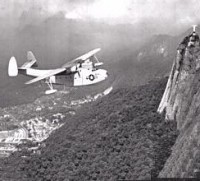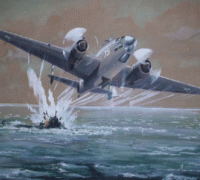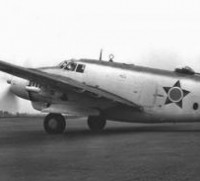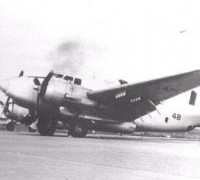- ANTI SUBMARINE TACTICS
11)PBY 5 CATALINA
PBY CATALINA
The Consolidated PBY Catalina, was produced as a flying boat and seaplane amphibian in the 1930s and 1940s. In Canadian service it was known as the Canso. It was one of the most widely used seaplanes of World War II. Catalinas served with every branch of the United States Armed Forces and in the air forces and navies of many other nations. The last military PBYs served until the 1980s. As of 2014, nearly 80 years after its first flight, the aircraft continues to fly as a waterbomber (or airtanker) in aerial firefighting operations in some parts of the world. None remain in military service.
Background
The PBY was originally designed to be a patrol bomber, an aircraft with a long operational range intended to locate and attack enemy transport ships at sea in order to disrupt enemy supply lines. With a mind to a potential conflict in the Pacific Ocean, where troops would require resupply over great distances, the U.S. Navy in the 1930s invested millions of dollars in developing long-range flying boats for this purpose. Flying boats had the advantage of not requiring runways, in effect having the entire ocean available.
Initial development
As American dominance in the Pacific Ocean began to face competition from Japan in the 1930s, the U.S. Navy contracted Consolidated, Martin and Douglas in October 1933 to build competing prototypes for a patrol flying boat. Naval doctrine of the 1930s and 1940s used flying boats in a wide variety of roles that today are handled by multiple special-purpose aircraft. The U.S. Navy had adopted the Consolidated P2Y and Martin P3M models for this role in 1931, but both aircraft were underpowered and hampered by inadequate range and limited payloads.
Consolidated and Douglas both delivered single prototypes of their new designs, the XP3Y-1 and XP3D-1, respectively. Consolidated's XP3Y-1 was an evolution of the XPY-1 design that had originally competed unsuccessfully for the P3M contract two years earlier and of the XP2Y design that the Navy had authorized for a limited production run. Although the Douglas aircraft was a good design, the Navy opted for Consolidated's because the projected cost was only $90,000 per aircraft.
Consolidated's XP3Y-1 design (company Model 28) had a parasol wing with external bracing struts, mounted on a pylon over the fuselage. Wingtip stabilizing floats were retractable in flight to form streamlined wingtips and had been licensed from the Saunders-Roe company. The two-step hull design was similar to that of the P2Y, but the Model 28 had a cantilever cruciform tail unit instead of a strut-braced twin tail. Cleaner aerodynamics gave the Model 28 better performance than earlier designs. Construction is all-metal, stressed-skin, of aluminum sheet, except the ailerons and wing trailing edge, which are fabric covered. The prototype was powered by two 825 hp (615 kW) Pratt & Whitney R-1830-54 Twin Wasp radial engines mounted on the wing's leading edges. Armament comprised four .30 in (7.6 mm) Browning AN/M2 machine guns and up to 2,000 lb (910 kg) of bombs.
The XP3Y-1 had its maiden flight on 28 March 1935, after which it was transferred to the U.S. Navy for service trials. The XP3Y-1 was a significant performance improvement over previous patrol flying boats. The Navy requested further development in order to bring the aircraft into the category of patrol bomber, and in October 1935, the prototype was returned to Consolidated for further work, including installation of 900 hp (670 kW) R-1830-64 engines. For the redesignated XPBY-1, Consolidated introduced redesigned vertical tail surfaces which resolved a problem with the tail becoming submerged on takeoff, which had made lift-off impossible under some conditions. The XPBY-1 had its maiden flight on 19 May 1936, during which a record non-stop distance flight of 3,443 mi (2,992 nmi; 5,541 km) was achieved.
The XPBY-1 was delivered to VP-11F in October 1936. The second squadron to be equipped was VP-12, which received the first of its aircraft in early 1937. The second production order was placed on 25 July 1936. Over the next three years, the design was gradually developed further and successive models introduced.
The aircraft eventually bore the name Catalina after Santa Catalina Island, California; the name was coined in November 1941, as Great Britain ordered their first 30 aircraft.
PBN Nomad
The Naval Aircraft Factory made significant modifications to the PBY design, many of which would have significantly interrupted deliveries had they been incorporated on the Consolidated production lines.[6] The new aircraft, officially known as the PBN-1 Nomad, had several differences from the basic PBY. The most obvious upgrades were to the bow, which was sharpened and extended by two feet, and to the tail, which was enlarged and featured a new shape. Other improvements included larger fuel tanks, increasing range by 50%, and stronger wings permitting a 2,000 lb (908 kg) increase in gross takeoff weight. An auxiliary power unit was installed, along with an improved electrical system, and the weapons were upgraded with continuous-feed mechanisms.
138 of the 156 PBN-1s produced served with the Soviet Navy. The remaining 18 were assigned to training units at NAS Whidbey Island and the Naval Air Facility in Newport, Rhode Island. Later, improvements found in the PBN such as the larger tail were incorporated into the amphibious PBY-6A.
Naming
The designation "PBY" was determined in accordance with the U.S. Navy aircraft designation system of 1922; PB representing "Patrol Bomber" and Y being the code assigned to Consolidated Aircraft as its manufacturer. Catalinas built by other manufacturers for the U.S. Navy were designated according to different manufacturer codes, thus Canadian Vickers-built examples were designated PBV, Boeing Canada examples PB2B (there already being a Boeing PBB) and Naval Aircraft Factory examples were designated PBN. In accordance with contemporary British naming practice of naming seaplanes after coastal port towns, Royal Canadian Air Force examples were named Canso, for the town of that name in Nova Scotia. The Royal Air Force used the name Catalina and the U.S. Navy adopted this name in 1942. The United States Army Air Forces and later the United States Air Force used the designation OA-10. U.S. Navy Catalinas used in the Pacific against the Japanese for night operations were painted black overall; as a result these aircraft were sometimes referred to locally as "Black Cats".
Roles in World War II
The PBY was the most numerous aircraft of its kind, with around 3,300 aircraft were built.
During World War II, PBYs were used in anti-submarine warfare, patrol bombing, convoy escort, search and rescue missions (especially air-sea rescue), and cargo transport. The type operated in nearly all operational theatres of World War II. The Catalina served with distinction and played a prominent and invaluable role in the war against the Japanese.
These patrol planes shared with land based patrol bombers the combat roles while the very long range Consolidated LB-30 and the Consolidated Coronado were pressed into service to increase the all important logistic strategic air lift capability in the vast Pacific theater. The pairings allowed the Catalina to take on the role of eyes of the fleets at longer ranges than the float plane scouts. Several different flying boats were adopted by the Navy, but the PBY was the most widely used and produced.
Although slow and ungainly, Catalinas distinguished themselves in World War II. Allied forces used them successfully in a wide variety of roles for which the aircraft was never intended. PBYs are remembered for their rescue role, in which they saved the lives of thousands of aircrew downed over water. Catalina airmen called their aircraft the "Cat" on combat missions and "Dumbo" in air-sea rescue service.
Anti-submarine warfare
Catalinas were the most extensively used anti-submarine warfare (ASW) aircraft in both the Atlantic and Pacific theaters of World War II, and were also used in the Indian Ocean, flying from the Seychelles and from Ceylon. Their duties included escorting convoys to Murmansk. By 1943, U-boats were well-armed with anti-aircraft guns and two Victoria Crosses were won by Catalina pilots pressing home their attacks on U-boats in the face of heavy fire: Flying Officer John Cruickshank of the RAF, in 1944, for sinking U-347 (although the submarine is now known to have been U-361) and in the same year Flight Lieutenant David Hornell of the Royal Canadian Air Force (posthumously) against U-1225. Catalinas destroyed 40 U-boats, but not without losses of their own. A Brazilian Catalina attacked and sank U-199 in Brazilian waters on 31 July 1943. Later, the aircraft was baptized as "Arará", in memory of the merchant ship of that name which was sunk by another U-boat.
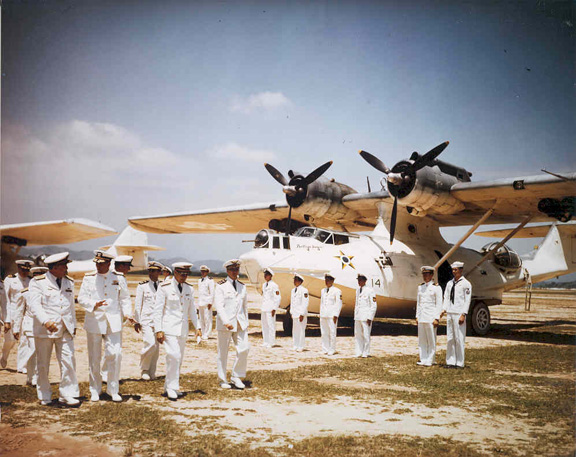
Above Brazilian Military seen during one inspection of 15 aircraft delivery at Galeao airbase Rio de Janeiro.
Maritime patrol
In their role as patrol aircraft, Catalinas participated in some of the most notable naval engagements of World War II. The aircraft's parasol wing and large waist blisters provided excellent visibility and combined with its long range and endurance, made it well suited for the task.
A RAF Coastal Command Catalina, piloted by Ensign Leonard B. Smith of the U.S. Navy and flying out of Castle Archdale Flying boat base, Lower Lough Erne, Northern Ireland, located on 26 May 1941, some 690 nmi (1,280 km; 790 mi) northwest of Brest, the German battleship Bismarck, which was attempting to evade Royal Navy forces as she sought to join other Kriegsmarine forces in Brest. This sighting eventually led to the destruction of the German battleship.On 7 December 1941, before the Japanese amphibious landings on Kota Bharu, Malaya, their invasion force was approached by a Catalina flying boat of No. 205 Squadron RAF. The aircraft was shot down by five Nakajima Ki-27 fighters before it could radio its report to air headquarters in Singapore. Flying Officer Patrick Bedell, commanding the Catalina, and his seven crew members became the first Allied casualties in the war with Japan.
A flight of Catalinas spotted the Japanese fleet approaching Midway Island, beginning the Battle of Midway.
A Royal Canadian Air Force (RCAF) Canso flown by Squadron Leader L.J. Birchall foiled Japanese plans to destroy the Royal Navy's Indian Ocean fleet on 4 April 1942 when it detected the Japanese carrier fleet approaching Ceylon (Sri Lanka).
Night attack and naval interdiction
During the Battle of Midway four USN PBYs of Patrol Squadrons 24 and 51 made an attack on the occupation force of the Japanese fleet on the night of June 3–4, 1942.
The Royal Australian Air Force (RAAF) also operated Catalinas as night raiders, with four squadrons Nos. 11, 20, 42, and 43 laying mines from 23 April 1943 until July 1945 in the southwest Pacific deep in Japanese-held waters, bottling up ports and shipping routes and forcing ships into deeper waters to become targets for U.S. submarines; they tied up the major strategic ports such as Balikpapan which shipped 80% of Japanese oil supplies. In late 1944, their mining missions sometimes exceeded 20 hours in duration and were carried out from as low as 200 ft (61 m) in the dark. Operations included trapping the Japanese fleet in Manila Bay in assistance of General Douglas MacArthur's landing at Mindoro in the Philippines.
Australian Catalinas also operated out of Jinamoc in the Leyte Gulf, and mined ports on the Chinese coast from Hong Kong to as far north as Wenchow. Both USN and RAAF Catalinas regularly mounted nuisance night bombing raids on Japanese bases, with the RAAF claiming the slogan "The First and the Furthest". Targets of these raids included a major base at Rabaul. RAAF aircrews, like their U.S. Navy counterparts, employed "terror bombs", ranging from scrap metal and rocks to empty beer bottles with razor blades inserted into the necks, to produce high pitched screams as they fell, keeping Japanese soldiers awake and scrambling for cover.
Search and Rescue
Catalinas were employed by every branch of the U.S. military as rescue aircraft. A PBY piloted by LCDR Adrian Marks (USN) rescued 56 sailors in high seas from the heavy cruiser Indianapolis after the ship was sunk during World War II. When there was no more room inside, the crew tied sailors to the wings. The aircraft could not fly in this state; instead it acted as a lifeboat, protecting the sailors from exposure and the risk of shark attack, until rescue ships arrived. Catalinas continued to function in the search-and-rescue role for decades after the end of the war.

Early commercial use
Flight steward Max White at work on board a Qantas Empire Airways Catalina aircraft en route from Suva to Sydney in January 1949 with young passenger Jennifer Grey.
Catalinas were also used for commercial air travel. For example, Qantas Empire Airways flew commercial passengers from Suva to Sydney, a journey of 2,060 miles (3,320 km), which in 1949 took two days.[23] The longest commercial flights (in terms of time aloft) ever made in aviation history were the Qantas flights flown weekly from 29 June 1943 through July 1945 over the Indian Ocean, dubbed the Double Sunrise. Qantas offered non-stop service between Perth and Colombo, a distance of 3,592 nmi (4,134 mi; 6,652 km). As the Catalina typically cruised at 110 kn (130 mph; 200 km/h), this took from 28 to 32 hours and was called the "flight of the double sunrise", since the passengers saw two sunrises during their non-stop journey. The flight was made in radio silence because of the possibility of Japanese attack and had a maximum payload of 1,000 lb (450 kg) or three passengers plus 143 lb (65 kg) of military and diplomatic mail.
Post-World War II employment
An Australian PBY named "Frigate Bird II", an ex RAAF aircraft, registered VH-ASA, made the first trans-Pacific flight across the South Pacific between Australia and Chile in 1951 by (Sir) Gordon Taylor, making numerous stops at islands along the way for refueling, meals, and overnight sleep of its crew, flown from Sydney to Quintero in Chile after making initial landfall at Valparaiso via Tahiti and Easter Island.
With the end of the war, all of the flying boat versions of the Catalina were quickly retired from the U.S. Navy, but the amphibious versions remained in service for some years. The last Catalina in U.S. service was a PBY-6A operating with a Naval Reserve squadron, which was retired from use on 3 January 1957. The Catalina subsequently equipped the world's smaller armed services into the late 1960s in fairly substantial numbers.
The U.S. Air Force's Strategic Air Command used Catalinas (designated OA-10s) in service as scout aircraft from 1946 through 1947.
The Brazilian Air Force flew Catalinas in naval air patrol missions against German submarines starting in 1943. The flying boats also carried out air mail deliveries. In 1948, a transport squadron was formed and equipped with PBY-5As converted to the role of amphibious transports. The 1st Air Transport Squadron (ETA-1) was based in the port city of Belem and flew Catalinas and C-47s until 1982. Catalinas were convenient for supplying military detachments scattered along the Amazon. They reached places that were otherwise accessible only by helicopters. The ETA-1 insignia was a winged turtle with the motto "Though slowly, I always get there". Today, the last Brazilian Catalina (a former RCAF one) is displayed at the Airspace Museum (MUSAL) in Rio de Janeiro.
Below an archival footage on the delivery of 15 PBY-5 to Brazilian Air Force in a ceremony occurred at Galeao Airbase, Rio de Janeiro on 12 Dec. 1944. These aircrafts were remanescents from VP-94 Squadron which were based at Natal, Belem, Maceio and Bahia between 15 Jan 1943 and Dec 1944.
Variants
An estimated 4,051 Catalinas, Cansos, and GSTs of all versions were produced between June 1937 and May 1945 for the U.S. Navy, the United States Army Air Forces, the United States Coast Guard, Allied nations, and civilian customers.
US Navy
XP3Y-1
Prototype Model 28 flying boat later re-designated XPBY-1, one built (USN Bureau No. 9459). Later fitted with a 48-foot-diameter (15 m) ring to sweep magnetic sea mines. A 550 hp Ranger engine drove a generator to produce a magnetic field.
XPBY-1
Prototype version of the Model 28 for the United States Navy, a re-engined XP3Y-1 with two 900 hp R-1830-64 engines, one built.
PBY-1 (Model 28-1)
Initial production variant with two 900 hp R-1830-64 engines, 60 built.
PBY-2 (Model 28-2)
PBY-3
Powered by two 1,000 hp R-1830-66 engines, 66 built.
PBY-4 (Model 28-4)
Powered by two 1,050 hp R-1830-72 engines, 33 built (including one initial as a XPBY-4 which later became the XPBY-5A).
PBY-5 (Model 28-5)
Either two 1,200 hp R-1830-82 or −92 engines and provision for extra fuel tanks (with partial self-sealing protection). 683 built (plus one built at New Orleans), some aircraft to the RAF as the Catalina IVA and one to the United States Coast Guard. The PBY-5 was also built in the Soviet Union as the GST.
XPBY-5A
One PBY-4 converted into an amphibian and first flown in November 1939.
PBY-5A (Model 28-5A)
Amphibious version of the PBY-5 with two 1,200 hp R-1830-92 engines, first batch (of 124) had one 0.3in bow gun, the remainder had two bow guns; 803 built including diversions to the United States Army Air Forces, the RAF (as the Catalina IIIA) and one to the United States Coast Guard.
PBY-5R
The XPBY-5A converted into a staff transport, with amphibious gear and nose turret removed and additional windows added.
PBY-6A used by the United States Coast Guard as a staff transport.
PB2B-1
Boeing Canada built PBY-5 for the RAF and RCAF from 1942. 240 built.
- General characteristics
-
Crew: 10 (pilot, co-pilot, bow turret gunner, flight engineer, radio operator, navigator, radar operator, two waist gunners and ventral gunner)
-
Length: 63 ft 10.875 in (19.47863 m)
-
Wingspan: 104 ft (32 m)
-
Height: 21 ft 1 in (6.43 m)
-
Wing area: 1,400 sq ft (130 m2)
-
Aspect ratio: 7.73
-
Empty weight: 20,910 lb (9,485 kg)
-
Max takeoff weight: 35,420 lb (16,066 kg)
-
Zero-lift drag coefficient: 0.0309
-
Drag area: 43.26 ft2 (4.02 m2)
-
Powerplant: 2 × Pratt & Whitney R-1830-92 Twin Wasp 14-cylinder air-cooled radial piston engines, 1,200 hp (890 kW) each
-
Propellers: 3-bladed constant-speed B
Performance
-
Maximum speed: 196 mph (315 km/h, 170 kn)
-
Cruise speed: 125 mph (201 km/h, 109 kn)
-
Range: 2,520 mi (4,060 km, 2,190 nmi)
-
Service ceiling: 15,800 ft (4,800 m)
-
Rate of climb: 1,000 ft/min (5.1 m/s)
-
Lift-to-drag: 11.9
-
Wing loading: 25.3 lb/sq ft (124 kg/m2)
Armament
-
3x .30 cal (7.62 mm) machine guns (two in nose turret, one in ventral hatch at tail)
-
2x .50 cal (12.7 mm) machine guns (one in each waist blister)
- 4,000 lb (1,814 kg) of bombs or depth charges; torpedo racks were also available
By https://en.wikipedia.org/wiki/Consolidated_PBY_Catalina
